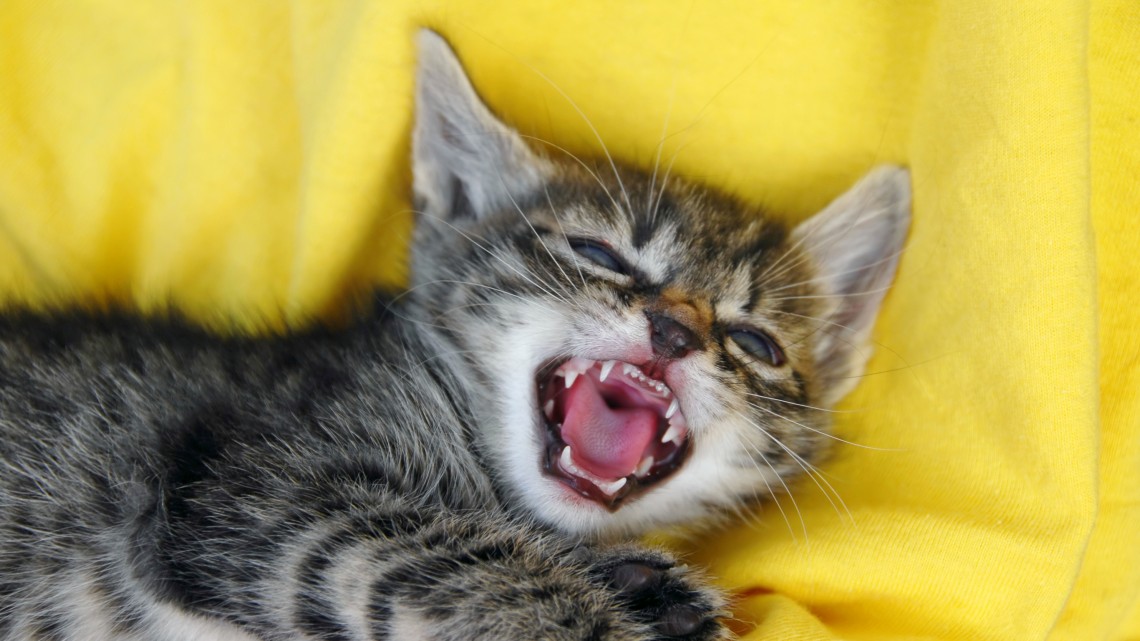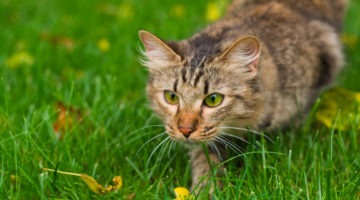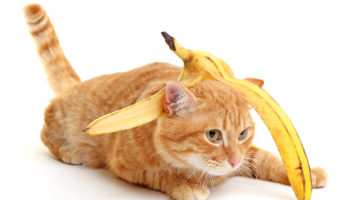It may sound like a stomach ailment, but it’s actually a painful oral disease that can seriously affect your cat’s overall well being. Here’s what you need to know about it, and how to keep your kitty healthy.
Does your cat have bad breath, or trouble chewing? Does he rub his head or face, or have difficulty grooming himself? If so, he may be developing stomatitis. It’s an inflammation of varying degrees of severity that afflicts various parts of a cat’s mouth. Stomatitis is an all too common feline malady that left unattended can mean much suffering and heartache, as well as expense. As the condition progresses, cats have great difficulty eat- ing, may become anorexic, feverish, drool and even have blood in their saliva.
What causes it?
So called allergic stomatitis, or feline lymphocytic- plasmacytic stomatitis, usually involves inflammation, infection and ulceration of the gums, the roof of the mouth and throat regions. It can be caused by an underlying viral infection such as feline immunodeficiency virus (FIV). This infection may trigger an autoimmune reaction that results in the production of antibodies that attack the delicate cells lining the mouth and around the gums. Other viral infections may also be involved, notably feline herpes, calicivirus and feline leukemia virus (FLV).
Feline specialist Dr. Elizabeth Hodgkins (co-author with myself and Professor Marion E. Smart of Not Fit for a Dog: The Truth About Manufactured Dog and Cat Food), avoids what many veterinarians do in severe cases of stomatitis: removing most if not all the cat’s teeth. She contends that in many cases a food hypersensitivity may be involved, compounded by the high acidity in the spray applied to most commercial dry cat foods to enhance palatability. The net result of inflammatory reactions in the mouth, and possible disruption of the healthy bacterial population, is an invasion of harmful bacteria and even fungi, the production of inflammatory substances called cytokines, and abnormal proliferation of gum tissue that may have to be removed with laser surgery along with loose and decaying teeth, all under general anesthetic.
Treatment plan
Stomatitis can be so painful that the cat must be anesthetize to be properly examined. Extensive oral inflammation and infection, adverse reactions to anesthesia and even death make these high risk patients for even the most experienced veterinarian.
- Dr. Hodgkins’ approach is to transition cats onto a moist, meaty diet, ideally home prepared, and to treat them with clindamycin and cyclosporine.
- I also recommend this integrative approach to help reduce inflammation and infection, along with a good quality fish oil supplement that has potent anti-inflammatory properties.
- Zyflamend herbal combination from New Chapter may prove beneficial when given as an oral supplement under veterinary supervision, along with aloe vera gel if afflicted cats will tolerate having their gums massaged.
- Dysbiosis, a disruption of healthy bacterial populations in the oral cavity and digestive system, can be aggravated by high-cereal content diets and genetically engineered corn and soy ingredients (for more details, visit twobitdog.com/DrFox). So part of the treatment regimen for cats with stomatitis is to correct dysbiosis by giving them probiotics.
Prevention tactics Until recently, dental problems in both cats and dogs were a neglected aspect of home health care. These problems include the buildup of tartar or scale on the teeth, gum inflammation or gingivitis as well as stomatitis, and serious periodontal disease and tooth root abscesses. Not only do affected animals develop nauseating halitosis and find it painful to eat, but the inflammation in their mouths can cause a spread of bacteria and cytokines into the bloodstream and internal organs. This can damage the heart, causing serious and often fatal heart disease, and also harm the kidneys, pancreas, liver and other internal organs.
These inflammatory substances are also produced from body fat in overweight and obese cats. Obesity and dental problems are associated with highly processed manufactured commercial pet foods, especially those high in cereals.
- Since prevention is the best medicine, starting cats out right from kittenhood on a moist, meaty, balanced whole food diet is probably the best insurance again stomatitis. Highly processed pet food ingredients, especially corn and soy glutens, leave micro-particles adhering to the teeth that foster dental disease. A natural meat-based diet will also help prevent the diet-related diseases often associated with stomatitis, notably diabetes mellitus, kidney disease (with uremia or ammonia poisoning), and food-related skin problems that are often treated inappropriately with cortocosteriods, which in turn can lead to chronic infections in the mouth and urinary tract.
- It is critically important, especially for older cats, to have a routine oral examination and teeth cleaning as needed. Get your cat used to regular in-home tooth cleaning and oral healthcare maintenance. Wrap a moist gauze bandage around your index finger and get your cat used to having his teeth and gums rubbed. Then, every night, rub very strong organic green or black tea, or some dry tea leaves, on the gums and between the teeth. This can help stop plaque accumulation and aid in the treatment of periodontal disease. The oral gel or spray made by PetzLife Oral Care Products (petzlife.com) loosens scale and tartar, and helps reduce inflammation and infection.
- Replace highly processed manufactured treats with natural food materials to help keep your cat’s teeth clean and gums healthy. Try giving him raw, scalded (to kill surface bacteria) chicken wing tips, chicken or turkey gizzard strips, or beef shank or heart slivers.
Stomatitis is an uncomfortable and difficult disease that can lead to serious health problems. The good news is that vigilant dental hygiene and quality nutrition go hand in hand in preventing it and keeping your kitty happy and pain-free.







No Comment